10/1/2020
Zero Waste, Maximum Growth
Bill Calkins
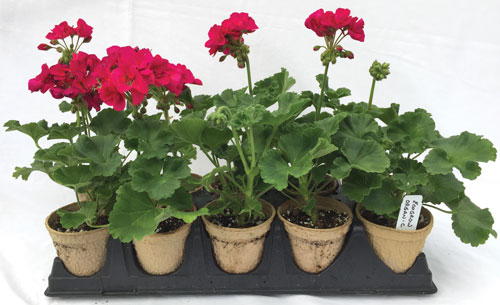
When most growers think about sustainable pots, visions of past iterations of fiber pots often come to mind. And those memories are not always pleasant. Pots breaking down in the greenhouse and retail (resulting in shrink and dump), and shoppers walking past displays covered in soil and little plant pieces turned a lot of growers off to biopackaging that was probably ahead of its time a decade ago. Thankfully, new versions of sustainable pots are not only much more shopper friendly, but also grower friendly after years of trialing and testing in real-world production and retail settings.
Pictured: Under normal greenhouse conditions, these direct-stick geraniums grown in EcoGrow pots finished with excellent uniformity and quality.
The HC Companies EcoGrow line of biodegradable pots has been in the market for about five years, and recent greenhouse and field trials have proven their product claims and validated grower testimonials, in terms of product integrity, performance and value-added benefits.
GrowerTalks hosted a webinar with territory sales manager and product development expert Bryce Anderson in June 2020 that detailed many of HC’s trial findings and we wanted to share some more info to help you decide if it’s time to explore eco-friendly container options for growing and selling annuals, perennials, vegetables, herbs and possibly even nursery crops. (Editor’s note: The webinar is more than an hour long and trials are covered in great detail. We suggest watching the archived version at growertalks.com/webinars for a thorough deep dive.)
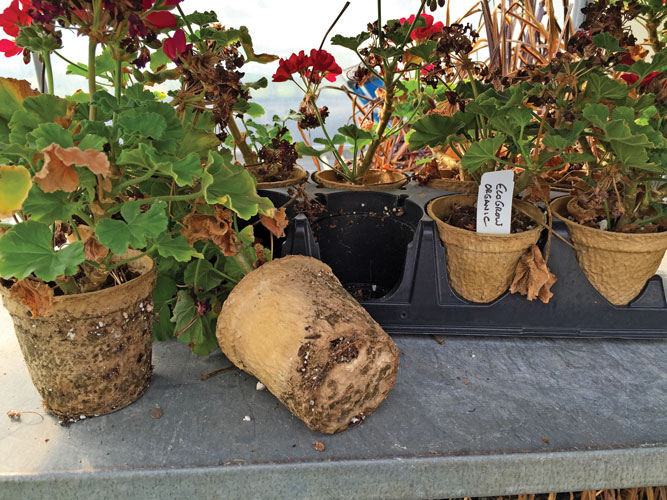 Goals & overview
Goals & overview
EcoGrow approached greenhouse trials with the goal of answering the most common questions from growers looking at the line: How do the containers hold up and how long do they last? They were looking for real-world data and applications. Bryce says they wanted to trial EcoGrow pots in different climates and growing situations.
“We needed to look at typical growing conditions in production greenhouses,” he explains.
Pictured: The HC Companies let this crop continue to grow well past its retail sale date and saw the pots maintain integrity, with little breakdown.
After trials to determine EcoGrow’s performance in various applications from propagation to finished production—including shifting from small pots into larger formats like combinations and deco pots, as well as bumping up perennials into finished retail sizes—the results were very positive. They even pushed the limits, according to Bryce, taking some crops from early spring propagation all the way into the fall to determine how the pots perform over the long term.
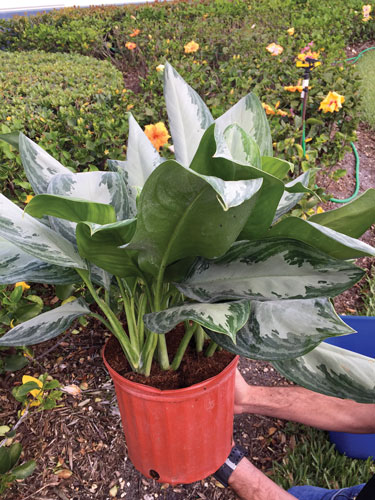 Pictured: EcoGrow pots were shifted up directly into finished containers and the resulting quality can be clearly seen.
Pictured: EcoGrow pots were shifted up directly into finished containers and the resulting quality can be clearly seen.
Bryce felt the results met or exceeded expectations in a few ways. After as long as seven months in greenhouse conditions and through summer, the pots held up extremely well, maintaining integrity and looking good, even after being subjected to more abuse than normal. Root development in propagation trials was excellent and root penetration was positive. And, according to Bryce, performance in real-life gardens where EcoGrow pots were planted directly into soil was positive with no difference in growth or vigor compared to traditional methods.
“When we dug plants up in the fall, the basic profile of the pot remained, but the material was disintegrated,” he says.
Trial experience
Let’s look at some of the trials in more detail. The HC experts worked with growers to conduct production trials using unrooted geranium cuttings direct stuck into biodegradable pots and traditional plastic pots.
“The plants in EcoGrow pots did better out of the gate,” Bryce says. “From my experience, this is because when using peat-based media, water is trapped in the media and turns to muck.”
He feels EcoGrow pots are more breathable and water drains through the pot, resulting in healthier roots as they develop. These findings also positively impact uniformity, which Bryce expected.
“What I observe is that all liners, including weaker ones, perform better because there is less waterlogging,” he explained.
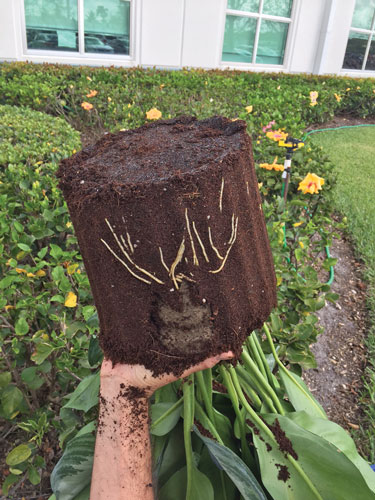 Pictured: When the plant is removed from the finished pot, healthy roots can be seen growing through the fiber pot.
Pictured: When the plant is removed from the finished pot, healthy roots can be seen growing through the fiber pot.
HC also conducted trials with herbs and perennials, showing similar results as annuals. The EcoGrow pots held up satisfactorily in the greenhouse through to retail. A need specific to perennial growers was to reduce the amount of plastic waste resulting from shifting up products from propagation to finished pots. Using biodegradable pots in propagation and then planting the pots directly into finished gallons solves this problem.
“We hear from perennial growers who wish they didn’t have to use plastic pots in propagation,” Bryce says. “EcoGrow allows them to shift up perennials and shrubs with zero waste by canning pot and all.”
For growers using 4-in. pots to build combos and deco pots, EcoGrow offers zero-waste benefits similar to those seen by perennial growers. And according to Bryce, trials proved the concept.
The method trialed included three approaches: first, were plants potted into combos with no pot at all, the traditional method. Next, an EcoGrow pot with the bottom torn off. Finally, EcoGrow pots planted directly into the final container. Trials showed absolutely no difference in terms of plant growth and quality, Bryce says.
“There’s no need to peel off the bottom of the pot; EcoGrow pots disintegrate into nothing and roots grow right through.”
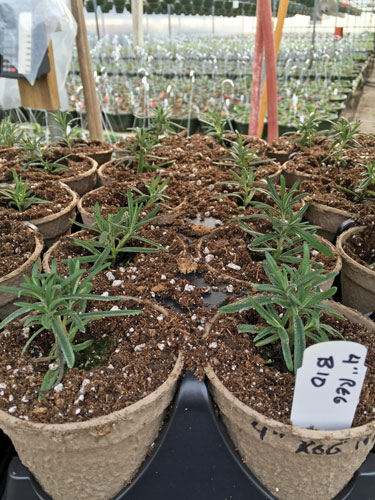 Learning curves & considerations
Learning curves & considerations
“EcoGrow pots are probably not the best option for two-year or multi-season crops,” Bryce explains. “The best use is for seasonal crops, in terms of retail appeal.”
Pictured: In a rosemary greenhouse trial, transplanted liners took off strong out of the gate due to the airflow and breathability of EcoGrow fiber pots.
Basically, biodegradable pots will biodegrade, and after a season, they won’t maintain the same high integrity as when they’re grown and sold in one season.
Another point to remember is more of a greenhouse best practice: overwatering will speed up the breakdown of biopots like EcoGrow. Bryce explained that if growers tend to overwater crops, challenges often arise with plant health and quality. This also negatively impacts the integrity of fiber pots. Moisture management is always important and this extends to growing with eco-friendly pots. But, as mentioned before, in the early stages, EcoGrow pots will help with uniform drying so growers will see benefits even if someone is heavy with the hose.
Value-added benefits
Why wouldn’t a grower use EcoGrow? Bryce says there’s always a risk when making changes and as a former grower, he always subscribed to the theory that if the current method is working (media, nutrition, pots, etc.), don’t make a change.
“But with EcoGrow, you need to look at it as a differentiation strategy, not just a change,” he explains. “This system creates an opportunity to add value.”
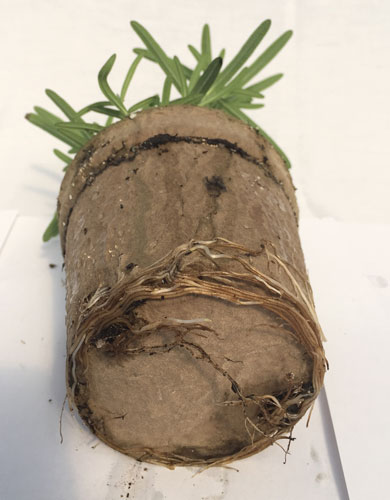 Pictured: Roots can be seen actively growing through the biopot, indicating excellent plant health.
Pictured: Roots can be seen actively growing through the biopot, indicating excellent plant health.
Retailers are asking for sustainable alternatives and many have a sense of obligation to do their part to reduce environmental impact, he says.
“Growers and retailers must do their part to harvest the benefits,” Bryce adds. “If biodegradable pots cost one cent more, then get five cents more at wholesale and 25 cents more at retail.”
In his experience, when customers ask for a sustainable option, they expect a higher cost. Look at cars, cleaning products and produce as examples. An electric car costs more. Natural cleaning products cost more. Organic produce costs more. In the consumer products industry, rarely do we see sustainable products priced the same, he says.
Finally, like is often suggested with new products and processes growers consider, don’t feel the need to go all in from day one.
“Although EcoGrow works through automation and will fit into matching flats for most sizes, just try a little bit,” he says. “If you grow 50 varieties of tomatoes, including seven heirlooms, start with the heirlooms.”
This will allow you to differentiate by SKU, add value and assess success or failure.
If you’ve been considering a move to biopots due to retailer interest, consumer trends or a desire to do your part to remove some plastic waste from the planet, the product quality and greenhouse functionality of today’s products like EcoGrow are solid. Trials have proven this and growers have shown success.
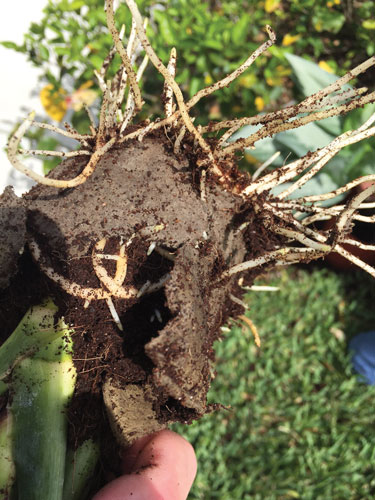 Pictured: Root health is consistently seen in The HC Companies’ EcoGrow greenhouse trials.
Pictured: Root health is consistently seen in The HC Companies’ EcoGrow greenhouse trials.
Consider starting with some of your production for spring 2021—especially as the industry looks to capitalize on new, younger shoppers who may have picked up their first plant in 2020 and caught the gardening bug. They might be the exact market to help us take biopots to the next level. GT
Want to learn more about HC’s fiber sustainable growing containers? Visit hc-companies.com/fiber-planting-containers to browse products, view additional resources or download the latest catalog. For specific questions regarding HC’s fiber growing trials, you can reach out to Bryce Anderson directly at BAnderson@hc-companies.com or by calling (800) 225-7712.